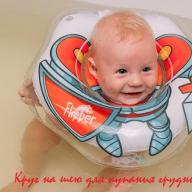So it came warm, sunny days, swimming, walking. Mood at height. So it's time to sit behind the machine and sew something new. 🙂
I suggest sew Children's Panamka On the girl, which is just relevant for the season.
p.S On the same scheme, you can sew a panama and a boy, reducing the width of the fields.
The process will not take much time. And the result will be beautiful and delight you and others, and most importantly - to protect your baby from the sun.
Materials:
- The main fabric is about square 0.5 x 0.5 m.
- Thermotkan for strengthening fields 7 cm. X 60 cm.
- Threads in tone or harmony in color with cloth
- Bow (flower) for decoration (optional)
- Tools (machine, scissors, needles for the backbone)
- Pattern
Panamka pattern can be easily drawn by this scheme itself:

 To build a pattern by the desired size measure the circle of the head and divide by 3.14 (og / 3.14 \u003d d) - It will be the diameter of the bottom of Panama.
To build a pattern by the desired size measure the circle of the head and divide by 3.14 (og / 3.14 \u003d d) - It will be the diameter of the bottom of Panama.
The radius of Panama fields is calculated by the formula:
R2 \u003d Head Circle / 2 * 3,14 + Panama Field Width (6-13 cm).
Tula - a rectangle AV \u003d A1B1 - scalp, AA1 \u003d BB1 - the depth of the product (usually 9 -10 cm.)
Solid geometry. 🙂
How to sew a children's panama. Master class with photo.
We cut out of the prepared fabric details of Panama (on this pattern):
We add an allowance for seams of 1.5 cm.
Tula - 2 details with a fold
Fields - 4 Details
Bottom panama 2 details
We sew two identical panamans.
1. Connect the fields panamki on side seams. Suts of iripature. It turns out two circles.


2. Connect the edges of the Tula. Seams are iround.
Strengthen Panamka fields with thermotalkani. Cut on the pattern without letters on the seams. Apply to the fields by Schellup side down! We put the iron on the part and keep 8 seconds. Alternately rearrange the iron to other parts of the part. Important: Do not drive it !!!
P. S. I have been made of two parts (technical situation 🙂). But it is better with one whole piece.

3. We attach the bottom of Panama to Tulier (face to face) with the help of the backbone or needles. Start a typewriter.

4. Connect parts of the panama (fields and cap) together with the background. Start a typewriter.

5. Repeat with the rest of the items. It turns out two identical billets.
P. S. Fields of internal panama can not be strengthened by thermotalkan.
6. "Face to face" attend one panama to another.

7. We make seams in a circle. Leave the hole to expand the product.
8. Soak our Panamu.
9. Close the hole. Toggle. Start over the edge of Panamka fields itself.

10. Send flower (bow), unscrewing the front half of the fields to the hat.


We catch a model and try. 🙂 Ours panamka On the girl is ready.
Look too,. Detailed master class.
By the summer: Hat, Cap, Panama, Bandana. Pattern
Hat.
At any time of the year on the streets of the city, the beaches, the cafe can be found a representative of the weaker sex in the headdress, which passed to us through the age-old thorns. We are talking about a female hat with fields, which is popular with women, especially in summer, to the beach season.
It turns out that she is not so difficult to sew a hat with the fields. To do this, we need a small amount of material that you will think of yourself, at your discretion, the pattern of hats and, of course, a good mood. The scheme of hats patterns proposed by us consists of three parts: Dysheko, Tula and fields.
After a little time and the applications of considerable strength you get a completely stylish women's hat with fields that can be worn almost everywhere. Most importantly, she will protect your head from the sun, rain, wind.

Cap
 Throughout the twentieth century, the cap was a headdress among different layers and classes of society. She was worn by leaders and presidents, shpan and thieves, athletes and scientists. All managed to use this headdress as the main, unshakable attribute of the outerwear.
Throughout the twentieth century, the cap was a headdress among different layers and classes of society. She was worn by leaders and presidents, shpan and thieves, athletes and scientists. All managed to use this headdress as the main, unshakable attribute of the outerwear.
Today, the cap is absolutely all: ranging from children, ending with pensioners and people of old age. As a rule, in the stores of the Caper the same. There is no such that no one would be. And women want individuality. You have to search on the Internet the pattern of the cap and start sewing. With you now and we will deal with!
As for the pattern, it is not necessary to look for it, it is. It is for this pattern of the caps that we will create a new headdress with you, which is not in your city! This pattern of the cap consists of ten items: six clins, two visors and two tempered.
Sew the cap on the presented pattern is very easy. The main thing is to know what to do what. The first thing to do is move the pattern of the cap on paper, leaving 1 centimeter for seams. Then you need to sew a wedge among themselves. It will be the bottom of our cap. Then you need to sew the lining of the cap. The most important part is a visor. It needs to be carved and gently sew. In order for the beacon of the caps to be hard, you need to make a special fliesline insertion of the same size. If it is not, you can use the usual cardboard. Then add the visor to the Tulle. To them shakes. That's all! Cap is ready!
That's how we sewed a new headdress, which you can wear when and anywhere!

Panama
 Summer in Russia is very hot. Sometimes, I don't even want to go out on the street. Hunting just lie on the sofa and sleep all day. Only in the evening the sun sometimes reduces the level of exposure to its bright rays, and people roll out to the streets.
Summer in Russia is very hot. Sometimes, I don't even want to go out on the street. Hunting just lie on the sofa and sleep all day. Only in the evening the sun sometimes reduces the level of exposure to its bright rays, and people roll out to the streets.
But walk in hot weather, in its very high peak, it is necessary. How to work, then in the store for products, and even just on the city beach - sunbath. Every time, going out to the street with a hot roast day, we have the opportunity to get a frantic sunlight and find yourself in the hospital. In order for such incidents, people did come up with a light summer panama, the sew of which I suggest to do you at leisure.
Using the Panama pattern proposed by me, you can easily and quickly sew stylish, lightweight, and most importantly, safe under the rays of the sun headdress. Panama pattern will help you correctly evaluate all the sizes and dimensions of the fabrics and material.

Bandana
 By itself, the bandana, as an element of clothing, entered the life of people long before the appearance of beretov, hats and hats. Her roots stretch from the times of the Wild West when travelers defended their respiratory travelers from dust by tapping the bandans on the neck.
By itself, the bandana, as an element of clothing, entered the life of people long before the appearance of beretov, hats and hats. Her roots stretch from the times of the Wild West when travelers defended their respiratory travelers from dust by tapping the bandans on the neck.
Today it is used more often for decorative and aesthetic purposes, rather than to protect against the sun and dust. Although, pay tribute, after many years the bandana does not cease to be one of the best hats, interrupting the scorching rays of the sun. For this pattern of bandans, you can sew it for half an hour.
Of course, this is the time that will go to the sewing of bandans. For sewing you need to choose the material. In principle, any elastic, but not dense fabric is suitable for this head. It can be skin, flax, soft drape, denim. Anything, the main thing that the material corresponds to these two important qualities.
After working with the pattern of bandans, you can handle its edges, apply decorative accessories at their discretion. That's all! Bandana is ready! Now it can be worn on the head, covering the sultry summer head from the scorching sun, on the belt, on the neck or hand. The main thing is that it is combined with your clothing style.
If you have children in the family, then you know how in the summer you need a hat or a cap, protecting the head of the child from sunlight. Try to sew this Children's Panama with your own hands. Such a children's hat is quite suitable not only for a girl, but also a boy. Such a panama model can be sewn even for the doll of your daughter.
This free master class gives a pattern for three sizes of the children's caps and a complete description of the technology of tailoring children's panama with their own hands.
Video, how to sew an original female (or for a girl) Summer two-sided Panama.
How to make a pattern of children's panama

The pattern of this model of the panama is simple, and the cap itself will be sewn just two identical parts. In order for you, I could start the sewing of Panamka, I make a completely free pattern of this panama. Pattern without letters, do not forget to add them during cut.

In order for you to have a pattern of this panama, you will need a printer and scotch.
If you have both, then select each image of the pattern and save them on the "desktop" of your computer or in a special folder. Then open each image in any graphic editor, for example, "Paint" and print them in full (100%).
Dimensions: in - (solid line) Pattern on a child 12-24 months. To - (dotted line) Pattern on a child 2-4 years old, C - from 4 to 6 years

Pay attention to points 20cm (15cm) and 23 cm. These are the control values \u200b\u200brequired to check the pattern after printing on the printer. If, after printing patterns, the lower horizontal of the left part will be 20 cm (right -15cm), and the vertical (line of connection of both parts of the pattern) will be 23 cm, then the pattern size is correct. If this data is slightly different, then you will need to configure the printer print settings or expand the pattern by any method known to you, for example, cutting it (in a glued form) vertically and horizontally and slide parts slightly.
Both parts of the pattern glue the scotch, then described on the tissue and turn this part along the fold line. Punches (1cm) on the contour and cut out.

In order not to spoil the paper, first print this test square. If the parties are equal to 13 cm, then you can print the details of the Panamka patterns.
Technology sewing children's summer panama

Sew this panama with your own hands is quite simple, it is enough to cut two identical parts of the caps from the same material or combine as in my master class.
Then scroll them with pins, or sweep, folding both parts by the front sides.

Stop these parts on the sewing machine along the winding loop of the panama, with a 1 cm allowed, as shown in the photo.
Be sure to leave the small plot not sewn, within 5-7 cm.

So that the panama looks neatly in the finished form, be sure to target the sections concave inside, as shown in this photo. Take care carefully not to cut the seam thread.

Convex sections, on the contrary, you need to cut. In this case, these curved areas will be well laid out.
How to turn the panama correctly

Now you will need to find the left hole left and twisted the panamu on it.

Turn it carefully in order not to break the connecting seam.

This is such a panama, outwardly, something similar to the marine slope.
Finishing lines along the edge of the panama

So that the seam laid neatly and smoothly, necessarily after turning the panama, secure it with oblique stitches, as shown in the photo.

Pass along the loop of Panamka, following the seams passing exactly along the edge.

The hole through which you turned out the cap, too, need to be found, with the same allowance.

Sew the hole will have to manually, neat invisible stitches.

After that, you will only have to make one or two finishing lines along the panamka contour.

Finishing line laying along the edge of the panama on the wrong side, departing from the edge of 2 mm. If you are going to make only one line, you can retreat and just over.

The edge of the panama, treated with two finishing lines, it seems to me, it will be more beautiful.
How to make a loop for buttons on Panama

On the Panamka pattern there is a layer markup for a button, for each of the three sizes of the header. Transfer this markup to the panama, mark the loop length and take a loop on the sewing machine.

Now, with the help of a unpacking, you need to cut a loop, watching not to damage the hinge threads.
How to adjust the size of the panama

If you make a mistake with the size of the panama, or your child will grow, the size of the panama can be easily changed.

To do this, it is enough to increase or decrease the distance between the buttons that you sewed on the rear portion of Panamka.

That's how nice and originally it will look like this hat back on your child's head or doll.

Inside such a panama is better to put a soft cotton fabric.
3. Screw the fabric on the resulting patterns, adding one centimeter on the seams. First you need to stack the sidewall, then insert the bottom. After that, the edges of the Panama need to be processed, and to sew to Panama the most important detail - fields and upper parts. Decorative decorations (ribbons, embroidery, beads) will go to the Panama finish, defining its purpose: beach or everyday.
The coquest hat is a mandatory addition to a monochrome or colorful summer dress, sundress, a trouser costume. It will not only protect you from sunlight and overheating, but also serve as an excellent accessory, give your way a light romance romance. Sew yummy hatsuitable for your outfits, you can do it yourself.

You will need
- - cartridge or paper paper;
- - scissors;
- - needle with thread;
- - 3 cm lacy ribbon, 120 cm long;
- - main fabric 55 cm;
- - Lining fabric 55 cm.
Instruction
1. Allow the pattern of summer hats, the top of which is sewn from the wedges, it will make your head tightly. Transfer the pattern on the tracing. Draw on it two concentric circles with a diameter of 18 and 37 cm. Cut the central circle and cut the paper on the outer circle. These are fields hats. Make a wedge pattern - draw an equilateral triangle with a base of 8.8 cm and a height of 17 cm. Its side slightly sharpening. Cut it out of paper - this is a wedge of the Tool of your hat.
2. .. patterns from the main and lining fabric cut over 1 details of the fields and 6 parts of wedges. Take a thread with a needle and wedge wedges with each other first from the lining fabric. Enter it and make sure that the top caps are fit to you. Adjust the top of the scalp. Smealage the wedges from the main fabric. Stretch all the seams of both parts on the sewing machine. Remove the background. Bind the seams carefully, smoothing them into both sides.
3. Squeeze the top hat and fields inside the face, notify them with each other. Do it for details out of the main fabric, then their lining. Stretch the split both parts on the sewing machine. Remove the background.
4. Start the detail from the lining fabric inside out and put it into the part, made of the main fabric. Note them to each other in a circle, along the seam connecting the top hat with its fields. Slow the hats field on the sewing machine in the form of concentric circles, first by seam, then retreating from the connecting seam by 2 cm. Make 5 such circles, not reaching the edge of 2.5 cm.
5. Apply inside with a 0.5 cm edge of the head of the main and lining fabric. Insert the lace tape between them, notify it, and then step the edges on the sewing machine. Remove the backbone and swallow the fields of your new hats. If you wish, you can attach an artificial flower on it or tie a long scarf of a thin chiffon around the trill.
This Panama is not only suitable for men, but also for women who prefer sports style.
Look at the photo, Panama is tightly sitting on the head, so it does not flit in the wind, wide fields are securely protected from the sun, and the denim and cotton lining perfectly passes the air.
The size of the panama pattern from jeans is suitable for 58-60 sizes. If you have more measurements or less, you can adjust the size of the Panama at fitting.
Build details of the pattern on paper, there must be three: Tula, fields and bottoms; Cut.

Write old jeans on the seams, and color items: 1 details. donkey; 2 children Tula and 2 children. Fields. T. K. Fabric I had in bulk, I got out the Tul from 4 parts, instead of the laid 2.
Do not forget about the allowances on the seams on each side of the part - about 0.7-1 cm.
 On the upper parts, reveal the lining. For the lining fabric, it is best to use natural fabrics - sitherges, flax, hazard, satin, etc. If the fabric is new, it is necessary to wash and stroke the hot iron to avoid shrinkage when washing Panama.
On the upper parts, reveal the lining. For the lining fabric, it is best to use natural fabrics - sitherges, flax, hazard, satin, etc. If the fabric is new, it is necessary to wash and stroke the hot iron to avoid shrinkage when washing Panama. 
How to sew a men's panama from jeans, master class
Details of the Tuli from the main and lining fabric are sewn, seams are irrigating and, if you wish, we are tightened.


Tullet from denim tissue coming. We make fitting. If everything suits, add on the sewing machine. If it does not suit the size, erect or extend on the seams, seeking good fit to the head.
Seams, if desired, tighten.

The same is done with the details of the lining fabric.

The details of the lining fabric fields glue adhesive-based phlizelin.

We sew the fields from the main and lining fabric on short sides, seams are wearing.

We estimate, and then we draw the edges of the fields on the sewing machine by departure, cutting up to 3 mm.


We sew the top edge of the fields, connecting the vertex and lining details.
 We accept, and then sew the fields on the sewing machine to details from denim (Tula + Dysyshko).
We accept, and then sew the fields on the sewing machine to details from denim (Tula + Dysyshko).
Follow the side seams and the mid-details of the coincidence!
 Then skew stitches are sewed with a lining tulia from the lining fabric.
Then skew stitches are sewed with a lining tulia from the lining fabric.
I am increasing the fields of Panama with finishing lines on the width of the paw.
 That's all! As you can see, spending quite a bit of time, everyone can sew a male Panama from jeans with his own hands.
That's all! As you can see, spending quite a bit of time, everyone can sew a male Panama from jeans with his own hands.




